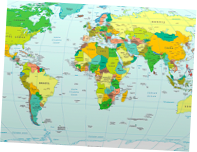

Pregnancy and Birth in Sweden
Sweden has the lowest infant mortality rate in the developed Western world, with less than 3 infant deaths per 1,000 births, in contrast to over 6 infant deaths per 1,000 in the United States. What factors lead to such low infant mortality?
In Sweden, health care is universal, which provides all pregnant women with access to health care providers for the duration of pregnancy and birth. 99% of women in Sweden receive prenatal care through the country’s complex network of maternal health clinics (McKay, 1993:117). Swedish midwives are autonomous caregivers who are employed by the national health service, and generally work in institutional settings. Swedish midwives are important contributors to favorable postpartum outcomes and receive “much credit for Sweden’s excellent perinatal outcomes” (McKay 1993:117). Becoming a Swedish midwife entails 4 and a half years of extensive training, an educational model that provides women with well-trained care providers.
Historically, infant mortality rates have been low in Sweden and were “believed to be a result of an extensive collaboration between physicians and highly competent, locally available midwives” (Högberg, 2008:1312) Even in the early 20th century, infant mortality rates in Sweden were less than half that of the United States.
Today, due to limited numbers of obstetricians, normal pregnancies are managed by midwifes, leaving obstetricians to focus on providing for high-risk or complicated pregnancies. With a normal pregnancy a woman begins prenatal care around 10 weeks at a community maternal-child health clinic, where she will be seen for the duration of pregnancy. A midwife will see the woman an average 11-12 times and an obstetrician will see her once or twice to assess her risk category (McKay, 1993:117).
Midwifes practice in either maternal-child health clinics or hospitals, but do not practice in both. As a result, the antepartum midwife is not involved in labor and delivery but performs postpartum examinations. In the hospital, women are cared for by midwifes throughout labor and delivery unless complications arise and a specialist is needed. While medical intervention, such as pain relief and fetal monitoring, are typical in Sweden alternative methods of pain management are also commonplace. In lieu of excessive use of pain management drugs, non-traditional techniques are commonly implemented, such as laboring in a pool of water and different labor positions that may provide more pain relief (McKay, 1993:118).
Swedes generally regard birth as an ordinary life event, while in the United States, it tends to be viewed as a pathological or medical condition. The Swedish model of midwifery care is centered on the needs of the woman and her family. Labor processes tend to be self-regulated, and rooming-in of mothers and babies is a common practice. Postpartum follow up care is provided to all women and is facilitated by community maternal-child health clinics (McKay, 1993:120). Midwifes are the “first line of care providers” for normal non-complicated births and pregnancies, and are also viewed as an essential part of the health framework that results in excellent peri- and postnatal health outcomes for both women and infants (McKay, 1993:120).



Developed Countries in the West
International Monetary Fund “Advanced Economies”
Austria, Belgium, Canada, Cyprus, Denmark, Finland, France, Germany, Greece, Iceland, Ireland, Italy, Luxembourg, Malta, Netherlands, Norway, Portugal, Slovenia, Spain, Sweden, Switzerland, United Kingdom, United States [Source]

CIA World Factbook “Developed Countries”
Austria, Belgium, Canada, Denmark, Finland, France, Germany, Greece, Iceland, Ireland, Italy, Liechtenstein, Luxembourg, Monaco, Netherlands, Norway, Portugal, San Marino, Spain, Sweden, Switzerland, United Kingdom, United States


